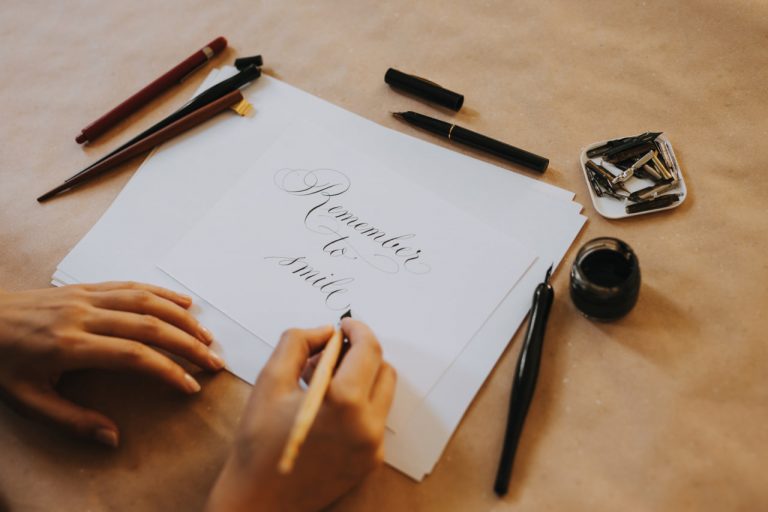Building a consistent lettering practice is essential, but sometimes daily drills and repeated alphabets aren’t enough to keep the motivation flowing. That’s where creative projects come in. They not only keep your routine fresh but also serve as powerful portfolio pieces, showcasing your unique voice, style, and versatility. Whether you’re an aspiring calligrapher, a hand lettering enthusiast, or building a lettering-based business, engaging in structured projects can bring clarity, confidence, and visibility to your work.
The Value of Project-Based Learning
Lettering projects challenge you to apply your skills to real-world contexts. While warm-ups and single-letter practice are important, working on complete pieces forces you to consider layout, consistency, composition, and audience. Projects encourage experimentation, help you discover what you enjoy most, and allow your creativity to flourish in ways that exercises alone cannot.
They also provide a sense of completion and progress. Seeing a finished piece—whether it’s a poster, greeting card, or logo—builds momentum and pride. Over time, a collection of such projects becomes a valuable portfolio that reflects your evolving capabilities and artistic identity.
Quote Illustrations
One of the simplest and most effective project types is the quote illustration. Choose a phrase or sentence that resonates with you—something motivational, poetic, humorous, or personal. The goal is to create a visual composition that reflects the tone and energy of the words through your lettering style.
Quote illustrations allow you to explore different letterforms, hierarchy, contrast, and embellishments. You can experiment with script and serif combinations, layout dynamics, and color integration. They’re also highly shareable and make excellent social media content or printables for your portfolio.
Alphabet Series
Designing an A-to-Z series helps you refine your consistency across letterforms while giving you the opportunity to explore stylistic variations. You might create a full uppercase alphabet in a modern brush style, then try a lowercase version in vintage serif. Or assign a theme to each letter—like emotions, cities, or animals—and build visual narratives around them.
This type of project reinforces rhythm and form while showcasing your ability to maintain cohesion across an entire set. Alphabet projects also serve as excellent reference material when creating logos, custom typography, or branding elements.
Envelope Addressing and Mock Wedding Suites
Calligraphy shines when applied to elegant, personal stationery. Practicing envelope layouts, RSVP cards, and place settings helps you refine spacing, legibility, and decorative flourishes. Even if you’re not working with real clients, creating a mock wedding suite or special event package adds a polished, professional touch to your portfolio.
You’ll also gain experience in formatting for real-world use, where space constraints and clarity matter. Practicing on different paper textures and envelope shapes introduces you to the practical aspects of ink flow and composition outside your sketchbook.
Daily Word Challenge
Create a list of 30 words—either self-generated or pulled from an online prompt list—and commit to lettering one each day. Focus on exploring a different style, technique, or tool for each word. One day you might use a brush pen, the next a monoline marker or pointed nib.
These bite-sized projects prevent overwhelm while building a diverse body of work. They also push you to think creatively, as you find ways to make each word visually interesting. At the end of the challenge, you’ll have a cohesive series to display as a collection or even compile into a digital booklet.
Branding and Logo Concepts
Imagining lettering-based brand identities is a powerful portfolio-building exercise. Choose a fictional business or redesign an existing one using your lettering. For example, create a hand-lettered logo for a coffee shop, fashion boutique, podcast, or wellness brand.
These projects encourage you to focus on communication, readability, and versatility. How does your lettering work at various sizes? Does it evoke the right mood for the brand? Branding work demonstrates that your skills go beyond art for art’s sake—you can solve design problems with style.
Greeting Cards and Posters
Seasonal or occasion-based lettering pieces are practical, relatable, and marketable. Design cards for holidays, birthdays, or milestones with expressive typography. Poster designs for events, quotes, or causes allow you to incorporate layout design and color theory into your lettering practice.
These formats also challenge your understanding of scale and print-readiness. You’ll learn to consider margins, framing, and how your work might look on paper, screens, or merchandise. These tangible projects are perfect for adding variety to your portfolio or even testing product ideas.
Style Studies
Choose a single word or phrase and render it in multiple styles: bold sans serif, whimsical brush, vintage serif, modern script, gothic, and so on. This practice deepens your understanding of form and contrast while allowing you to demonstrate your range.
Style studies are especially useful if you’re trying to discover your voice. By playing with extremes, you’ll naturally gravitate toward certain aesthetics, revealing where your strengths and preferences lie. These can also serve as excellent teaching or workshop materials if you plan to share your knowledge.
Visual Storytelling
Lettering can go beyond words—it can tell stories. Create an illustrated scene where lettering is part of the environment. Maybe it’s a cityscape with hand-lettered signage or a recipe layout with illustrated ingredients and script instructions.
Combining illustration and lettering adds richness to your portfolio and demonstrates a wider design thinking ability. These projects are great for showcasing conceptual creativity and storytelling, making your work stand out in artistic and commercial contexts.
Build a Portfolio That Reflects You
The most compelling portfolios aren’t just a collection of pretty letters. They tell a story—of skill, curiosity, growth, and voice. Through creative projects, you can capture all of that. Whether you’re aiming to freelance, teach, or simply keep growing as an artist, regular, purpose-driven projects are the bridge between practice and mastery.



